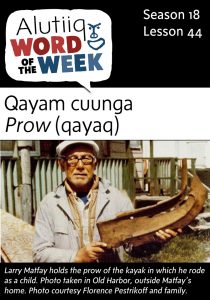Qayam cuunga – Prow; Bow (qayaq)
Qatayaq qayam cuungani misngauq. – The seagull is landed on the bow of the kayak.
From the Arctic Ocean to Prince William Sound, Alaska’s Native people crafted swift, seaworthy qayaqs from wood and animal skins. Each culture had a distinct style of boat with unique qualities designed for their environment.
Yup’ik qayaqs were short and broad, designed for stability in the ice-filled waters of the Bering Sea. Alutiiq qayaqs were long and slender, built to withstand the rough, windy waters of the North Pacific Ocean.
One of the most distinctive elements of the Alutiiq qayaq is its split, upturned prow. Like the boats size and shape, this part of the qayaq helps with navigation. The lower curved part of the prow slightly hollow on the sides, helping the boat cut through the water. The tall upper part provides buoyancy, helping the boat to float as it encounters waves.
The Alutiiq qayaq prow also helped paddlers identify each other. See a paddler in a split prow qayaq heading towards you and chances are that you are about to encounter another Alutiiq person, someone who speaks your language and may even be a relative.
An Alutiiq legend tells of the origins of the split qayaq prow. According to this story, the first man and women who entered the world, paddled between two cliffs. When the cliffs closed in on their boat, they broke one end, creating the curved prow that still characterizes Alutiiq qayaqs.
Source: Alutiiq Museum
